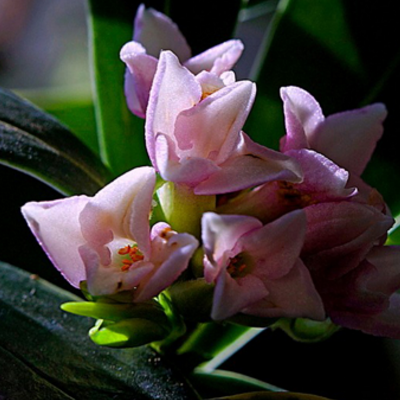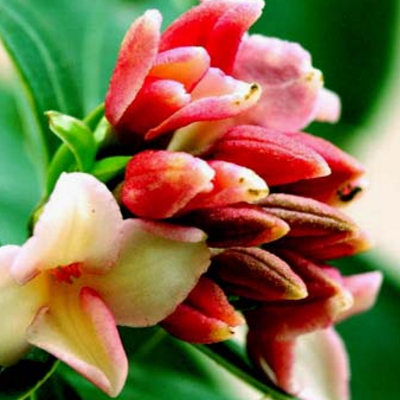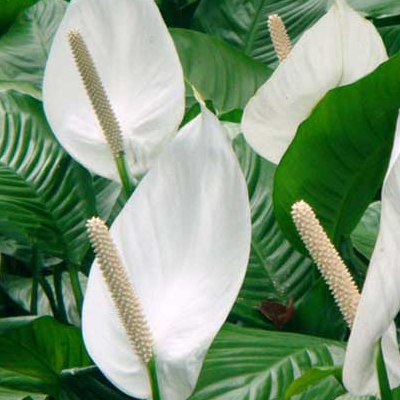Is the hydroponic culture method of Daphne odorifera toxic?
Daphne, this is a plant, is a lot of people like to cultivate, flowers are not general incense, daphne hydroponic method is what kind of? Is it poisonous:

The water culture method of Daphne odora:
1. Material selection
Before hydroponics, you should first choose a vessel that can put branches. The space is best to be large and oxygen is sufficient, which is conducive to rooting.
In addition, if you want long-term hydroponics, you can prepare a beautiful glass container, which can be placed for viewing after rooting.
Plastic foam board, clean pebbles, loose soil after eating.
2. Branch selection
Select the semi-lignified healthy branches of the current year (the branches are a little green), cut the length to 6~8 cm, and retain 1~2 leaves. On the day before cutting branches, you can use a sharp knife to draw a circle on the incision to accelerate wound healing.
3. Determine the time
The hydroponics of Daphne odora var. marginata can be carried out in all seasons of the year, but the highest survival rate is still in summer. The best time is in late July in Shandong and early July in southern China. Because the branches tend to mature at this time, root faster.
4. Operation method
First of all, the lower end of the branch from the middle split a hole, with small stones will be separated from the two halves of the branch.
Then soak the branches in the disinfectant for about 10 minutes and remove them after disinfection.
According to the thickness of the branches, insert a number of small holes in the plastic plate, insert the branches into them, and expose the lower ends of the branches by about 3~4 cm.
Then put the plastic foam in a container filled with water, the bottom of the branch should touch the water surface, and put it indoors in the morning sun.
5. Maintenance
2~3 days for a change of water, spring water, river water is best, or store a few days of tap water. When changing water, moss may appear around the utensils, clean them up and disinfect them with potassium permanganate solution.
If the weather is hot, add water to the container and sprinkle water on the ground in time. General temperature in oh 22~28℃ conditions, about 50 days can take root.
Is it poisonous:
Rumors are just rumors, and there is no scientific basis, Daphne really no poison. And the study also showed that Daphne odora has anti-inflammatory, immune regulation, analgesic, bacteriostatic, anti-tumor effects.
Daphne hydroponic method is introduced here, Daphne is not toxic, you can rest assured that farming.
Breeding methods and prices of Caragana
Caragana alias yellow finch flower, soil soybean, sticky socks, sauce petals, sun finch flower, yellow thorn, leguminous, Caragana is a deciduous shrub, several feet high, clustered, slender branches hanging soft. Do you want to know about it? Today, I will briefly introduce the breeding method of Caragana... Caragana feasible sowing, cuttage, sub-plant, layering and other methods of propagation. It is best to sow with picking, such as dry storage, seed soaking and germination before sowing in the next spring; cuttage can be carried out in February ~ March for hardwood cuttage, or in plum season for softwood cuttage, cutting into 8~12 cm, cutting depth 1/2, planting after shade, moderate watering, rooting after removing shade shed, fully accept light, robust growth, survival rate is high, branch propagation in spring 2~3 months...... Caragana likes light and drought tolerance, so it should be placed in a place with sufficient sunshine and smooth air. Winter is also relatively cold-resistant, the south of the Yellow River can be outdoor winter, the best even buried in the soil basin. Watering Master the principle of "Do not water if it is not dry, but water it thoroughly"........................................... Especially in the period, should keep the basin soil moist, can prolong flowering. Liquid fertilizer can be applied once in winter dormancy period; liquid fertilizer can be poured once before flowering in spring to prolong flowering period; after flowering, topdressing can be applied once to promote the growth of branches and leaves, and appropriate amount of thin fertilizer can be applied at ordinary times. After defoliation in winter, Caragana can cut off all kinds of branches that affect the tree shape; after flowering in spring, cut short the flowering branches to promote new flowering branches; during the vigorous growth period, you can trim the long branches at any time, and properly pick the core to maintain the graceful posture of the tree shape.............................................. Caragana turn pot every 2~3 years, time is appropriate in early spring. When turning over the pot, about 1/2 of the old soil can be removed, the fresh culture soil can be replaced, the root system can be trimmed, the new planting can be placed at the scattered place, the water can be poured thoroughly, and the atomized water can be sprayed to the pile head frequently, and the normal management can be restored after rejuvenation. For Caragana main branches can be appropriately curved shape, but pay attention to the effect of each surface, do not only bend on the same plane; for twigs are mainly trimmed, do not cut the same length, in order to appear uneven. When changing soil and pots, we should make use of the twisted and changeable root system of Caragana to arrange and arrange the root system, entwine each other, or properly climb it with brown silk to make it present the beautiful state of intertwined roots.... Conclusion: Caragana contains protein, fat, carbohydrates, vitamins, minerals and other components. It is slightly warm and sweet in nature, and has the effects of nourishing yin, regulating blood and invigorating spleen. Today's introduction to Caragana is here. Thank you for your appreciation and wish you a happy life. [Article Source] Flower Bonsai
Flower bonsai
✿ 天竺葵有毒吗✿ 康乃馨花束图片✿ 石榴花什么时候开 ✿ 印度橡皮树✿ 凤凰木图片✿ 蓝色马蹄莲✿ 杜鹃花有毒吗✿ 红色玫瑰花图片✿ 迎春花是什么颜色 ✿ 合欢花图片✿ 君子兰开花 ✿ 发财树养护✿ 长寿花怎么养 ✿ 建兰的养殖方法✿ 害羞草的养殖方法✿ 水培富贵竹 ✿ 藏红花图片✿ 白菊花图片✿ Copyright © 2016 - 2017 www.300.cn All Rights Reserved. Supported by ChemNet ChinaChemNet Toocle Copyright Notice
A complete list of breeding methods for large flower clivia
....... Clivia grandiflora is native to mountainous forests in southern Africa, with perennial temperatures of 15-25 ° C, thus forming the habit of fearing cold and heat and requiring warm, humid and semi-shady environments. Do you want to know how this plant, originally grown in Europe, should be raised? Today, Xiaobian will briefly introduce the breeding method of Clivia grandiflora to everyone. Fashion new favorite! Decorate the space new choice! Creative decorative flowers! Click to view>>...... Clivia grandiflora to seed propagation before first preparing the culture soil. There are many materials available for making culture soil, but one that is easier to obtain is loose soil with sufficient humus taken from the top of the forest and mixed with 1/3 clean fine sand soil.... Clivia breeding substrate, with wood shavings, can also use wood chaff, or fine sand, some also use rotten leaves, I suggest the best use of wood shavings, or wood chaff. Then look for plastic baskets, or you can use ventilated tile pots. Take wood shavings as matrix soil for example, disinfect first, then soak the disinfected wood shavings in water, put them into baskets, put them under pressure and level them............................................. Put the seeds of Clivia grandiflora into warm water, about 20~30 degrees Celsius, and then put the small eyes of the seeds down one by one, spaced apart and arranged in good order. After arranging, cover the seeds with 2~3 cm of wood shavings and flatten them neatly. After the above procedures are completed, water is sprayed through the basket, and the basket is placed in a ventilated place............................................... Clivia grandiflora breeding should be based on ventilation and moisture. Because of the first breeding, generally open the shavings to see the seeds, so pay attention to wash hands, or use clean small sticks to turn over............................................ The substrate must not be contaminated with oily substances. Oily seeds are infected. Moisturizing. Usually see shavings wet prevail, do not water every day, too much water will make the seed moisture variable rot; too dry and then water there is no moisture, the seed is too dry to sprout................................................. The adaptation temperature of Clivia grandiflora is generally between 15 and 30 degrees. Do not put the seeds in places above 10 degrees. Generally, it is too cold to keep warm with lights. Lanyou in the south can move to the balcony with sunshine at noon to warm up. Water quality, it is best to trap tap water for a day, then water, do not use tap water directly, because tap water has chlorine, affecting seed germination.............................................. Clivia grandiflora flowering in general in February to April, flowering, can be appropriate cooling, ventilation and reduce the light method to extend the flowering. The length of Clivia flowering period can be controlled by people's cultivation technology... Conclusion: Clivia grandiflora is a perennial herb with excellent leaves, flowers and fruits, enjoying leaves is better than watching flowers. "Although flowers do not need to ask, only the gentleman pressure Qunfang." Today's introduction to the cultivation method of Clivia grandiflora is here. Thank you for your appreciation. [Article Source] Flower Bonsai
Flower bonsai
✿ 天竺葵有毒吗✿ 康乃馨花束图片✿ 石榴花什么时候开 ✿ 印度橡皮树✿ 凤凰木图片✿ 蓝色马蹄莲✿ 杜鹃花有毒吗✿ 红色玫瑰花图片✿ 迎春花是什么颜色 ✿ 合欢花图片✿ 君子兰开花 ✿ 发财树养护✿ 长寿花怎么养 ✿ 建兰的养殖方法✿ 害羞草的养殖方法✿ 水培富贵竹 ✿ 藏红花图片✿ 白菊花图片✿ Copyright © 2016 - 2017 www.300.cn All Rights Reserved. Supported by ChemNet ChinaChemNet Toocle Copyright Notice
- Prev

Is Daphne the most fragrant flower? culture methods and matters needing attention
Ruixiang, this is a kind of plant, to blossom, this flower fragrance is not ordinary fragrance, is this Ruixiang the most fragrant flower? What are the breeding methods and precautions of Ruixiang: is Ruixiang the most fragrant flower? some people think so, but there is no data to show. Known as Qianli incense, it is said that her fragrance is strong and elegant.
- Next

Plain sailing is it poisonous? what are the breeding methods?
Plain sailing generally refers to the white taro, flowering is very beautiful, so plain sailing is poisonous? What are the smooth sailing breeding methods? Plain sailing is poisonous: plain sailing is poisonous. The smooth surface is non-toxic, the toxin exists only in the juice, and the skin feels burning, red and swollen after contact.
Related
- Fuxing push coffee new agricultural production and marketing class: lack of small-scale processing plants
- Jujube rice field leisure farm deep ploughing Yilan for five years to create a space for organic food and play
- Nongyu Farm-A trial of organic papaya for brave women with advanced technology
- Four points for attention in the prevention and control of diseases and insect pests of edible fungi
- How to add nutrient solution to Edible Fungi
- Is there any good way to control edible fungus mites?
- Open Inoculation Technology of Edible Fungi
- Is there any clever way to use fertilizer for edible fungus in winter?
- What agents are used to kill the pathogens of edible fungi in the mushroom shed?
- Rapid drying of Edible Fungi

